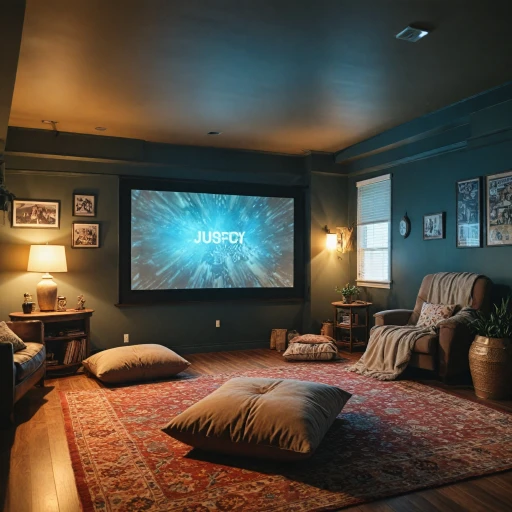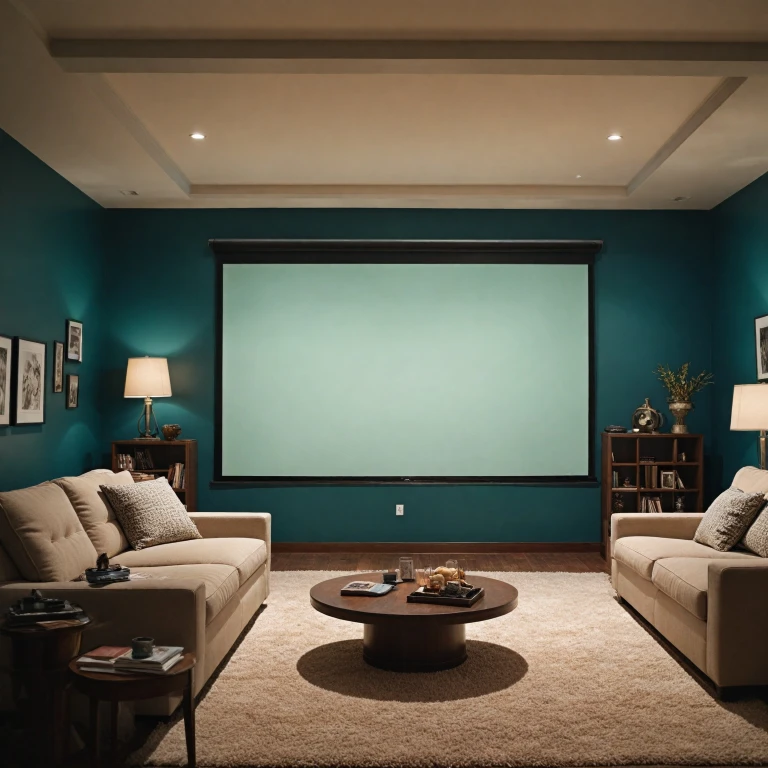Understanding the Basics of Projector Screen Paint
What Makes Projector Screen Paint Different?
When it comes to achieving theater-like visuals in the comfort of your home, the choice of screen paint is pivotal. While traditional screens have been the go-to, paint tailored for projector screens is growing in popularity. But what distinguishes it from conventional wall paint?
Designed for Optimal Projection
Screen paint is specifically crafted to enhance the projection quality. Unlike regular wall paint, it manages the reflection of light, making it suitable for both bright and dim environments. This means your perceived screen brightness and contrast will remain consistent regardless of room light levels.
Colors Tailored for Screens
The pigmentation of screen paint is scientifically engineered to absorb and reflect light in ways that contribute to optimizing the overall picture quality. Paint options range from neutral gray tones, which help with high contrast and ambient light control, to specialized white paints that maximize gain.
Coats and Application Methods
Applying the perfect number of paint coats, typically two to three, can dramatically influence how your projector image appears. Whether you're using a roller or spray, a good screen paint ensures even spreading without streaks or patches, crucial for both short throw and ultra short throw projectors.
The considerations don't just end at coat application. You'll find tips for the DIY approach that could transform your mundane wall into a stunning projection canvas, discussed later in this blog.
Enhancing your home theater experience with these professional touches can make a significant difference. For those seeking to maximize their viewing setup, exploring advanced options like
enhancing your home theater experience with an automatic movie screen could take your movie nights to the next level.
Comparing Paint vs. Traditional Screens
Contrasting Standard Screens with Paint Alternatives
Choosing between a traditional projector screen and opting to paint your wall as a screen can be daunting for some, but understanding the benefits of each can point you in the right direction.
Traditional screens, whether fixed, retractable, or electric, do provide a pristine and controlled surface for your projector. This makes them the go-to for high-end setups where maximum picture quality is essential. These screens are often designed to minimize light reflection and are coated with materials to enhance gain and contrast, optimizing projector brightness and room conditions.
However, if you're looking for a more flexible and potentially budget-friendly option, using paint to create a "screen wall" can be an excellent alternative. With screen paint, you have the capability to tailor the wall to your specific projector's throw distance and room dynamics. You can experiment with neutral gray paint for improved contrast in ambient light environments or select a high-contrast product for vivid colors, making it perfect for high definition short throw or ultra short throw projectors.
An additional advantage of a "paint screen" is its adaptability in a multi-use room. It seamlessly blends into your wall or ceiling, ensuring the surface can serve a dual purpose without the obtrusion of standard screens. Keep in mind that applying a few good coats with the right roller will ensure better results.
For more detailed insights on how to maximize your setup using projector screen paint, consider reading more on how to
enhance your home theater experience with projector screen paint.
Types of Paint Suitable for Projector Screens
Exploring Different Paints for Projector Screens
Choosing the right type of paint for your projection screen can greatly impact the quality of your home theater experience. The paint you select will influence the brightness, contrast, and overall visual quality of the projected image. Below, we explore the various types of paint that are ideal for creating a flawless projector screen.
Screen Paints Designed for Projectors
There are specific paints available on the market formulated with properties that make them perfect for home theater use. These screen paints are designed to produce high-definition projections and enhance the light-reflective qualities of the screen. They typically provide a higher "gain" than standard white or wall paints, meaning they reflect more projector light back to the viewer, which is particularly beneficial in rooms where ambient light might be an issue.
Neutral Gray Paints for Enhanced Contrast
If your setup supports short throw projectors or ultra short throw projectors, and you anticipate having some ambient light in the room, a neutral gray paint might be a good choice. Neutral gray helps enhance contrast, maintaining dark blacks without washing out bright whites during projection. This type of paint is especially useful for throw projector setups where high contrast scenes are common.
White Paint: The Traditional Choice
White paint is often touted as a traditional choice for projection screens due to its simplicity and wide availability. White screens are beneficial in totally dark rooms, where projector brightness will not be compromised by competing ambient light. Applying multiple coats can help achieve an even and clean surface, ensuring a good projection quality.
Black Paint for Special Occasions
In some cases, a black screen wall might be desired for unique projection needs. While less common, using black allows for vibrant, high contrast scenes suitable for highly controlled lighting environments. However, this approach requires very specific light conditions and might not be the best choice for all users.
Using the correct paint ensures you get the most out of your projector and enhances your overall viewing experience. For those who still seek the ultimate home theater experience, checking how Atmos speakers can further transform your setup can be a valuable exploration
here.
DIY Tips for Painting Your Projector Screen
Step-by-Step Guide for Painting Your Projector Screen
Embarking on a DIY projector screen painting project can be quite rewarding, offering a personalized touch to your home theater. To achieve the best result, it’s essential to approach the task methodically and with the right tools. Here’s how to get it done:
- Prepare the Wall: Before you start, ensure the wall is completely smooth. Sand down any bumps or imperfections until you have a flat surface. A properly prepped wall will help the paint adhere better and result in a cleaner finish.
- Choose the Right Paint: Depending on your projector type (standard, short throw, or ultra short throw) and the room's ambient light conditions, select the appropriate paint. White paint is versatile, but for rooms where light control is a challenge, high-contrast neutral gray can improve image quality by enhancing black levels and contrast ratios.
- Prime the Surface: Applying a primer of good quality ensures that your chosen screen paint will bond well with the wall. Priming helps even out wall porosity and enhances the final brightness and contrast of the projected image.
- Apply Screen Paint: Use a roller for even application and apply at least two coats. Be sure to let each coat fully dry before applying the next. This creates a smooth, even surface that is ideal for high definition projections. Additionally, pay close attention to achieving an even texture to help in the gain effect, improving how well the screen reflects light.
- Final Touches: After the last coat is dry, inspect the wall ceiling's edges where the paint might meet another surface. Clean up any drips or uneven lines to maintain a professional appearance.
With careful preparation and patience, your painted projection screen will rival traditional projector screens, potentially even outperforming them in particular environments. By maximizing your projector's capabilities, this DIY project can significantly enhance your overall home theater experience, making movie nights even more enjoyable. Remember, achieving a great result might take some practice, but the payoff will be worth the effort.
Common Mistakes to Avoid When Painting a Projector Screen
Avoiding Common Pitfalls When Painting a Projection Surface
To ensure you achieve a top-notch projection quality, it’s crucial to be aware of the common mistakes many encounter when painting a screen wall. These errors can affect the brightness, contrast, and overall performance of your projector screens.
- Choosing the Wrong Paint: One of the most frequent mistakes is opting for regular wall paint instead of specialized screen paint. The right product, like high contrast or neutral gray paint, is essential for maintaining optimal image quality and gain.
- Ignoring Surface Preparation: The wall surface must be smooth and free of imperfections before painting. Any bumps or textures can distort the projection, especially in high definition setups. A well-prepared wall ensures uniform light reflection.
- Poor Ambient Light Control: Ambient light can wash out the image. Consider using dark curtains or a light-controlled room to enhance the projection’s clarity. Short throw and ultra short throw projectors particularly benefit from minimized room light.
- Inadequate Coats: Insufficient coats of paint will result in uneven application and poor screen performance. Ensure you apply enough coats to achieve even coverage for a smooth projection surface.
- Using the Wrong Tools: To achieve a smooth finish, use high-quality rollers instead of brushes. A good roller will help avoid streaks and ensure a uniform application across your screen wall.
- Not Considering Viewing Angles: If you position your wall screen at a bad angle, it can impact the perceived brightness and contrast for viewers. Ensure the screen is perfectly aligned with the seating area.
By sidestepping these common pitfalls, your home theater experience will be greatly enhanced, allowing you to fully enjoy vivid and crisp images from your projector.
Enhancing Your Home Theater Experience with the Right Paint
Maximizing Impact with the Right Choice
To truly amplify your home theater experience, the paint you choose for your projector screen plays a crucial role. A well-selected product enhances brightness, contrast, and the overall picture quality of your display.
When transforming a wall into a projection screen, the key is selecting paint that can effectively manage ambient light conditions in your room. If your space is prone to excessive light, opting for a wall paint with high contrast qualities, like a neutral gray or specialized screen paint, can provide a significant gain in viewing quality.
For those using throw projectors or even ultra short throw options, choosing a paint screen with the right reflectivity is vital. Light-colored paint, like a specially formulated white paint, is often recommended to maximize the reflection when the projector's light hits the screen wall, ensuring a clear and crisp image. However, when aiming for a high-definition experience, consider the nuances of your projector’s specifications, such as lumens and aspect ratio, to ensure your paint choice complements these factors.
Moreover, applying multiple coats with a roller can create a smoother and even surface, reducing imperfections in projection. This may sound straightforward, but rushing the process can lead to common mistakes. Consistency in your paint application will play a part in achieving that good result.
Finally, don’t overlook the ceiling and wall colors in your room. Opt for darker shades to prevent the light spill and enhance the focus on the projection screen. Investing in the right paint will ensure your home theater provides a cinematic experience, making movie nights far more memorable.

